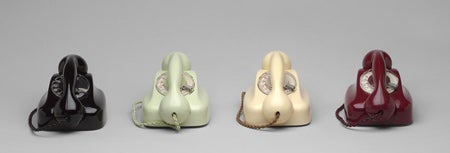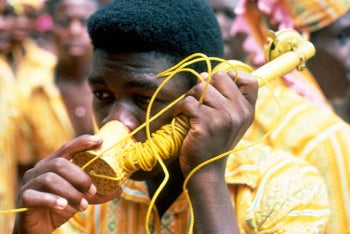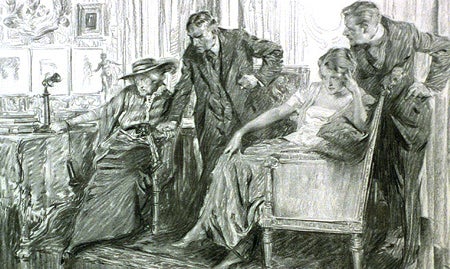
The initial entry of our new Focus series presents a chronicle of the telephone using some of the numerous collections in the Artstor Digital Library that center on history.
In 1876, inventors Elisha Gray and Alexander Graham Bell independently designed an “apparatus for transmitting vocal or other sounds telegraphically” and delivered their respective plans to the patent office on the same day. Bell, however, was the first to patent and has thus most often been credited as having invented the first practical telephone. The first successful telephone call happened on March 6, 1876, when Bell, in one room, famously called to his assistant in another room, “Come here, Watson, I want you.”

The telephone became a business by the summer of the following year. Bell and initial investors Thomas Sander and Gardiner Hubbard created the Bell Telephone Company, and the first private lines were placed in service, typically connecting a businessman’s home and his office.

By 1880, a short four years after the first phone call, there were more than 60,000 phones in America, and by 1904 the number had boomed past three million. By 1914, the US had become the world leader in teledensity, surpassing previous leaders Sweden, New Zealand, Switzerland, and Norway.
The earliest telephones had only one opening for sound through which the user alternately listened and spoke. The longest lasting type of telephone was introduced in the early 20th century, a model in which the transmitter and receiver were joined in a single molded plastic handle and the coupling transformer, battery, ringer, and dial switch in a cradle base unit. After the rotary dial was added, the instrument changed little until the 1960s, when touch-tone signaling began to become more widely used.

Mobile phones evolved from two-way radios permanently installed in taxicabs, police cruisers, and other vehicles. By 1948, wireless telephone service was available in almost 100 cities, but the network could not handle large call volumes, the phones were cumbersome, and the cost of calls comparatively expensive. It wasn’t until April 3, 1973, nearly 100 years after the first phone call, when a Motorola manager placed a call on a two-and-a-half-pound cellular phone to the head of research at AT&T’s Bell Labs, that the era of the true mobile phone began.
Resources:
- The Eyes of the Nation: A Visual History of the United States (Library of Congress) features an early sketch by Bell of his invention.
- The Schlesinger History of Women in America Collection includes several images of switchboard operators from the late 19th century, as well as telephone-related photographs spanning throughout the 20th century.
- George Eastman House features several photographs of telephone workers, from operators to manufacturers, from the early 1920s.
- You can find a selection of color photographs of early telephone models in the Carnegie Arts of the United States Collection.
- The Museum of Modern Art, Architecture and Design Collection features images of many cellular phones.
- The World War I and II Posters and Postcards (University of Minnesota Libraries) collection includes many images of telephone ads and propaganda of the period.
- The Library of Congress Collection includes some humorous telephone-themed cartoons from the early days of the technology.



